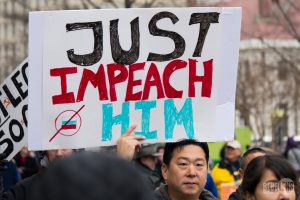by Shireen T. Hunter
According to reports in the U.S. media, former Secretary of State John Kerry in meetings with Javad Zarif , Iran’s minister of foreign affairs, expressed the view that it would be better for Tehran to wait out the remaining years of the Trump administration before engaging in new talks with a Democratic successor. Actually what Secretary Kerry in his interview with Fox News host Dana Perino said was: “ Well, everybody is waiting around talking about waiting out President Trump.”
Whether this statement amounts to Kerry advising Zarif not to engage with the Trump administration is debatable. However, it is not in Iran’s interest to wait out Trump. Doing so would exacerbate Iran’s many economic and political problems, prompt Washington to impose even more restrictions on Iran, and even increase the risk of potential American military attack.
Such a strategy of waiting out Trump assumes that the policies of previous U.S. administrations toward Iran were significantly different from those of the Trump administration. It also assumes that a future Democratic administration, or possibly even a more moderate Republican president, would adopt a different approach toward Tehran. Yet the Iran policies of past administrations from 1988 onwards strongly indicate that such a change is unlikely to happen. A major reason for this skepticism is the changed international setting since the Soviet Union’s collapse.
The End of the Cold War and US-Iran Relations
Throughout most of the 1980s, the U.S. approach to Tehran was greatly influenced by the Soviet factor and the ongoing Cold War. This is one reason why the United States did not pressure the Islamic Republic beyond a certain point and did not take direct military action against it, even during the hostage crisis of 1979-1981. Washington feared that excessive pressure and, even more so, military attack could provide Moscow with a pretext to move into Iran or otherwise dominate it.
Since the USSR was already in Afghanistan, this was a real possibility. Moscow’s domination of Iran would also have seriously undermined the U.S. position in the Persian Gulf. This latter concern was behind the enunciation of the Carter Doctrine.
By 1987, the situation, and hence American calculations regarding Iran, began to change. This was the year that Mikhail Gorbachev started his reforms and announced the so-called New Thinking in Soviet foreign policy. According to this new approach, the USSR’s foreign policy was to be determined by national interest calculations and not ideological competition with the West. And, according to the New Thinking, Moscow’s foreign policy was to help its economic revitalization. This change in Soviet thinking was, in fact, the beginning of the end of the Cold War.
Impact on U.S. Policy
This change in the USSR’s foreign policy outlook also meant that Moscow would no longer challenge the United States in the Middle East and in the Persian Gulf, including Iran. Thus, in April 1988, the United States attacked Iranian ships and oil platforms. These attacks eliminated any remaining Iranian hopes of defeating Iraq and led it to to agree to a ceasefire in its war with Iraq. After the end of the Iran-Iraq war, despite Tehran’s overtures, America chose Saddam Hussein’s Iraq as its new partner in the Persian Gulf only to be rudely disappointed when Baghdad attacked Kuwait in 1991. At that time, America made an overture to Tehran to join the anti-Saddam coalition. Iran’s domestic politics did not allow such a bold gesture, but Iran remained largely neutral, which helped the anti-Saddam coalition’s victory.
Soon after the Soviet Union’s collapse in December 1991, Secretary of State James Baker announced during a trip to Central Asia that the George H. W. Bush administration would block Iran’s presence in the post-Soviet space. Then came the Clinton administration’s dual containment policy, the 1996 economic sanctions, and the continued effort to keep Iran out of the developing regional energy and transport networks. The ultimate goal of the dual containment strategy was also regime change: through sanctions and other pressures, not the use of force.
Under the influence of 9/11, dual containment changed into a policy of active regime change in several Middle Eastern states, of which Iran was one. The George W. Bush administration, for instance, included Iran as one of three countries in its “axis of evil.” But even the Obama administration, especially while Hillary Clinton was secretary of state, pursued a policy of pressure rather than incentives. Clinton’s language regarding Iran was not much milder than that of Donald Trump. At one point, she said that, if Iran attacked Israel, America would obliterate it. She was also the first to talk about imposing crippling sanctions on Tehran. In fact, the worst of the sanctions came under the Obama presidency. Clinton also claimed that her insistence on severe sanctions brought Iran to the negotiating table. The Obama administration, too, mulled over the idea of a military strike on Iran. Had Clinton won the presidency in 2016, she, too, would likely have pursued a harsh policy toward Tehran.
The slow implementation of those aspects of the Joint Comprehensive Plan of Action (JCPOA) related to sanctions relief under President Obama triggered Iran’s complaints. During the remaining months of the Obama presidency, there were no breakthroughs in banking operations and no major U.S. investments in Iran. Immediately after the Obama administration signed the JCPOA, it raised the issue of missiles. In short, Donald Trump has merely escalated the dispute further. The essence of his policy, namely bringing Iran to its knees through pressure, is the same as those of the last four American administrations.
Continuity of Policy
U.S. policy toward Iran has been remarkably consistent because the main irritants in U.S.-Iran relations have remained the same since the establishment of the Islamic Republic. Despite episodes of tactical cooperation in Afghanistan and even for a while in Iraq and offers to resolve differences, Iran’s anti-American rhetoric and sometimes actions have continued. Also, Iran’s position on Israel and the Palestinian issue hasn’t changed. As long as Iran doesn’t resolve its dispute with Israel, there’s little hope of normalizing relations with Washington under any president. It is no secret that Israel and its supporters have greatly contributed to America’s harsh policy toward Iran.
In light of this history, waiting for Trump to go in the hope of getting a better deal from America will only lengthen the suffering of Iran and its people. In 1980, Iran delayed reaching an agreement on the hostage crisis in the hopes of getting a better deal from Jimmy Carter’s opponent. This tactic, however, undermined Iran’s then relatively moderate president, Abol Hassan Bani Sadr, enhanced the position of hardliners, and plunged the country into a devastating eight-year war with Iraq.
The Trump administration has adopted a predictably hostile stance toward Iran. But Iran will probably not get an appreciably better deal from whoever comes next.






If Iran ends up breaking the hold of the US dollar over its economy by developing alternative payment systems, no one will care what happens after Trump because the US infuence over Iran will for all intents and purposes be over
“As long as Iran doesn’t resolve its dispute with Israel, there’s little hope of normalizing relations with Washington under any president.” As if it is the fault of Iran, and not USI.
In 1980, no mention of the plot to ensure no agreement before the election of Reagan.
A very biased (pro-USA) article.